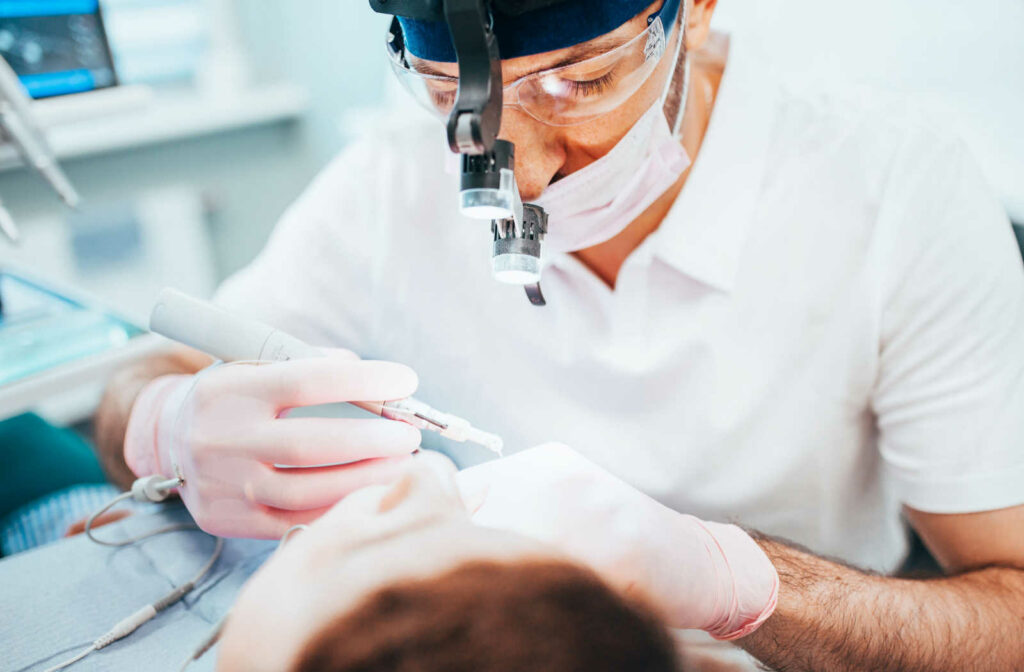A cavity can seem insignificant at first, but putting off a visit to your dentist can lead to complications. Ignoring a cavity can cause an infection requiring swift dental care. If necessary, can your dentist pull an infected tooth?
In short, yes, your dentist can pull an infected tooth, as long as they have the pain in control. If they cannot freeze your tooth, you’ll need to go on antibiotics for 3–7 days before they can extract it.
Your dentist may need to refer you to an oral surgeon in more severe cases. No matter what, it’s best to deal with an infected tooth sooner rather than later.
Continue reading to learn more about infected teeth, including how your dentist can treat them.
What Is an Infected Tooth?
An infected tooth may also be called a tooth abscess, a pocket of pus that develops in or around the tooth due to bacteria. This infection can happen at the tip of the tooth’s root or on the side near the gums, causing significant discomfort.
Symptoms of a tooth abscess include:
- Severe discomfort in the tooth, around the tooth, jawbone, neck, or ear
- Fever
- Discomfort with hot or cold temperatures
- Discomfort with pressure from biting & chewing
- Swollen face, cheek, or neck
- Tender or swollen lymph nodes under the jaw or in the neck
- Bad smell coming from the mouth
- Sudden poor tasting fluid in the mouth if the abscess ruptures
Tooth abscesses don’t go away on their own—they require treatment from your dentist. Otherwise, the infection can spread into your jaw and lead to serious complications, putting your health at risk.
How Does a Tooth Become Infected?
A tooth infection can be in the tooth (the pulp), around the tooth (periodontitis), or a combination of both. If an infection is in the gums, your dentist can freeze the gums and deep clean them and the pocket near the tooth. They can provide antibiotics to treat the infection first if they can’t freeze the gums.
A tooth becomes infected when bacteria gets inside its inner layers, causing an abscess. Bacteria enter your tooth when it erodes the tooth’s enamel. This problem is more commonly known as tooth decay or a cavity.
Tooth decay occurs due to poor dental hygiene, such as not brushing and flossing your teeth. Plaque, a clear sticky coating, develops on your teeth when bacteria mix with sugars and starches from food and drinks. With time, plaque begins eating away at your enamel, the protective outer layer of your tooth.
Once plaque breaks into the inner layers of your tooth, bacteria can travel further and cause an infection.
Tooth decay generally goes through several stages as bacteria eventually cause a tooth abscess:
- Initial plaque formation: Plaque develops when bacteria mix with sugars & starches in your mouth. In fact, plaque forms every 24 hours, even if you don’t eat.
- Enamel decay: Plaque eventually begins to wear down the enamel, the protective shell of your tooth. When bacteria break through the enamel, it becomes a cavity your dentist must fill. If left untreated, bacteria make their way into the deeper layers of your tooth.
- Dentin damage: Bacteria go further into the tooth, where it damages the dentin, the layer of the tooth between the enamel & your pulp. Because dentin is softer than enamel, this part of the tooth can decay quicker.
- Pulp damage: Your pulp is the centre of your tooth that holds tissue, nerves and blood vessels. An infection can develop when bacteria reach the pulp, causing a pocket of pus to form.
- Abscess formation: An abscess is a significant infection in your tooth that can lead to other health problems. It requires treatment as soon as possible.

Can a Dentist Pull an Infected Tooth?
Yes, your dentist can pull an infected tooth—generally, the sooner they extract it, the better. Your dentist can remove this infection with an extraction, root canal, or a deep cleaning if it’s in the gums. The method they suggest depends on the type of infection you have.
Removing a tooth isn’t always the first option. The overall goal of treating an abscess is to get rid of your infection without sacrificing your tooth—one way to do this is with a root canal.
A root canal involves drilling into the tooth to remove the decayed tissue and drain the infection. After removing the abscess, your dentist fills and seals the inner tooth before applying a crown to help protect it. If an infection reaches the pulp, it places pressure on the tooth and causes pain, which is when you may need a root canal.
While dentists generally avoid pulling an infected tooth, sometimes it’s necessary for your oral health. Many patients may wait until their symptoms and discomfort are too hard to ignore. Your dentist will freeze your mouth or sedate you, remove the infected tooth, and drain the abscess to remove the infection.
An infected tooth is treatable as long as your pain is under control. If your dentist can freeze the area without any issue, they can extract the tooth or deep clean the gums. If the infected area is difficult to freeze, they may prescribe antibiotics and reschedule an extraction or deep gum cleaning to a later date.
If your infection is severe, your dentist may refer you to an oral surgeon to have the tooth extracted under sedation. Symptoms of a severe infection include:
- Difficulty breathing
- High fever
- Dramatic swelling
- Inability to open your mouth
What to Do If You Have an Infected Tooth
The best thing you can do if you have an infected tooth is to visit your dentist as soon as possible. With swift action, your dentist can help treat your infection and prevent tooth loss. Tooth infections can lead to serious health problems if left untreated, so don’t ignore the symptoms of an infection.
Visit your dentist if you experience discomfort in your mouth and jaw, have trouble eating certain foods or chewing, or have swelling in your jaw or cheek.
If you have severe pain, you can control it until you see your dentist by combining Tylenol and ibuprofen. Call your dentist to get the right dosage information before taking any medication.
Don’t Ignore a Toothache
Your dentist is here to help if you have an infected tooth, but you can prevent infections with good dental hygiene and regular visits to your dentist’s office. Most people experience cavities at least once, but you don’t need to let this problem worsen until it becomes an infection. A potential filling can be better than a root canal or tooth extraction. Don’t brush aside a toothache—contact your dentist at Southgate Dental Centre if you experience symptoms of a cavity.



